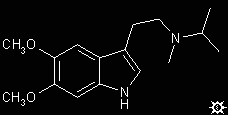
#41. 5,6-MEO-MIPT
TRYPTAMINE, 5,6-DIMETHOXY-N-ISOPROPYL-N-METHYL; INDOLE, 5,6-DIMETHOXY-3-[2-(ISOPROPYLMETHYLAMINO)ETHYL]; 5,6-DIMETHOXY-N-ISOPROPYL-N-METHYLTRYPTAMINE; 5,6-DIMETHOXY-3-[2-(ISOPROPYLMETHYLAMINO)ETHYL]INDOLE

|
| [3D .mol Image] |
A well-stirred suspension of 0.55 g LAH in 25 mL anhydrous THF was treated, dropwise, with a solution of 0.53 g 5,6-dimethoxy-N-isopropyl-N-methylindoleglyoxlamide in 75 mL anhydrous THF. The reaction mixture was brought to reflux temperature, held there for 30 min, and cooled to about 40 °C. There was added 0.55 mL H2O followed by 1.65 mL 10% aqueous NaOH and an additional 0.55 mL H2O. The solids were removed by filtration and the filter cake washed with THF. The combined filtrate and washings were stripped of solvent under vacuum. The oily residue was crystallized from hexane to give 0.34 g (yield 71%) 5,6-dimethoxy-N-isopropyl-N-methyltryptamine, mp 71-73 °C. MS (in m/z): C5H12N+ 86 (100%); indolemethylene+ 190 (4%); parent ion 276 (9%).
DOSAGE : > 75 mg, orally
DURATION : unknown
QUALITATIVE COMMENTS : (with 35 mg, orally) "Nothing at all."
(with 75 mg, orally) "There was a vague awareness of something at about the one-hour point. Not enough to even be called a threshold effect."
EXTENSIONS AND COMMENTARY : This compound, having no detectable activity even at the milligram / kilo level, pretty much condemns the 5,6-dimethoxy indole pattern. Quite a few closely related derivatives have been made; there is the N,N-dimethyl (5,6-MeO-DMT), the N,N-diethyl (5,6-MeO-DET), the N,N-dibutyl (5,6-MeO-DBT) and the three famous heterocyclic ring compounds, the pyrrolidyl (5,6-MeO-pyr-T), the piperidyl (5,6-MeO-pip-T) and the morpholyl (5,6-MeO-mor-T) compounds. They were all synthesized and characterized in the 1960's, but I have no record of any having been tried in man.
One desoxy analogue warrants mention. This is known as 5-methoxy-6-methyl-DMT (5,6-MeOM-DMT) or as 5-methoxy-6,N,N-trimethyltryptamine (5-MeO-6,N,N-TMT), where the 6-methoxy group is, in effect, replaced with a 6-methyl group. Having a DMT skeleton, it was assayed parenterally, and even at 15 milligrams (smoking) there was nothing noted. This is a level that would have been dramatic had there been no substitution at that 6-position. Some of the historical background of an oxygen at this position is discussed in the 6-HO-DMT recipe.